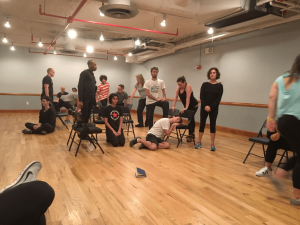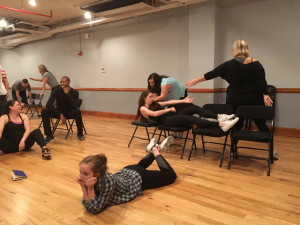CCE Mini Grant Reflection by Akhila Khanna, Eliza Renner, Nolan Ellsworth and Miguel Castillo.
Thanks to the generous contributions of the Middlebury College Community Engagement Mini Grant, and the Middlebury College Theatre Department, the four of us attended a Frantic Assembly workshop at the Actors Movement Studio in New York City on October 8th 2016.
Frantic Assembly is an internationally touring devised theatre company based in London that specializes in theatre-making by interweaving physically dynamic choreography with text (https://www.franticassembly.co.uk/). Having studied the devising methodology in our class with Professor Cheryl Faraone ‘Directing and Creating’ we were eager to work first-hand with Frantic Assembly artists from London and physically engage in the creation of an original piece.
A few of the most effective exercises that we were taught in the workshop began with two people gently squeezing five different parts of each other’s body (eg: right wrist, left knee, left hand, both shoulders, back neck). We were then instructed to fluidly go from one squeeze to the next creating a movement sequence with our partner. Without realizing we were each twisting and turning our bodies into shapes we didn’t even know we could create with our physical selves. What made the exercise so special was that each of us ended up creating powerful and intimate moments with complete strangers of different body types, ages and performance experience.
We then did a similar exercise sitting on chairs, limiting the majority of our movement to our hands, looking out into the audience. After both exercises as we each watched different pairs present their choreography we found ourselves creating a narrative in our head inspired by the visual spectacle created by physicality. The lifts between Miguel and David (a 45 year old professor at the University of Missouri) evoked the tenderness of a father-son relationship (see video with Miguel and David: https://youtu.be/Jgg9qAmskzE) When Coreen, a middle-aged director from Boston casually linked her arms with Nolan’s during their choreography on a chair without losing her eye contact with the audience, everyone watching broke into fits of laughter.

The Chair Exercise in Groups
We were then instructed to layer our movement with unrelated text such as a matrimonial advertisement to explore how two seemingly random elements can create a story. (See video with Akhila and her partner Doreen: https://youtu.be/C-NZOXo6Js8 and Miguel and his partner: https://youtu.be/TmJhaFUZDfo)
By the end, layers of instructions had taken effect on our movement pieces, making them unrecognizable from the simple combination of gestures they began with. The pieces had an everyday, non-dancer quality to them. That simple “pedestrian” movements could evoke a narrative was something we as artists had not yet explored. This exercise invited us into a completely new and innovative method of creating artistic material for the stage: the use of our physical selves rather than a pre existing text to come up with a play.

Exploring Pedestrian Movement
An aspect of their philosophy we collectively appreciated was inclusivity. They emphasize the idea of working with the resources and the bodies that people bring with them. It is not about achieving something impossible but about turning the ordinary into extraordinary.
Moving forward, we cannot wait to share some of the exercises we learned with our fellow classmates in the theatre and dance departments. As a group, we plan to meet up regularly to practice this new style of theatrical creation with one another. Play and experimentation will lead to discovery, which will inform Akhila and Nolan’s senior thesis that we are all involved in.